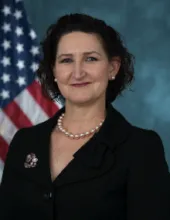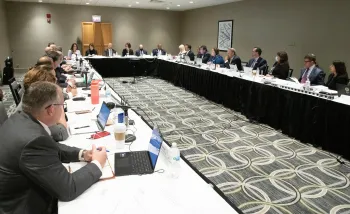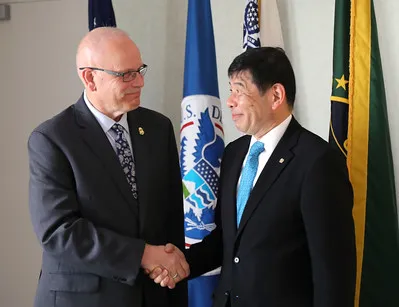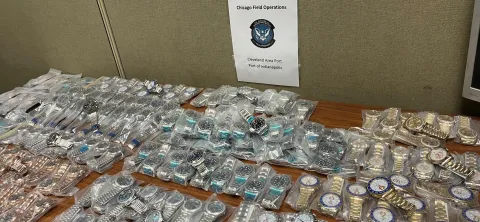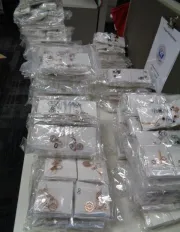EAC's Message
Never a dull moment in the Office of Trade! Lately, the keywords for us have been outreach, outreach, outreach. Commissioner Chris Magnus recently hosted the Secretary General of the World Customs Organization while Deputy Commissioner Troy Miller engaged with the trade community as co-host of the Sept. 14 Commercial Customs Operations Advisory Committee public meeting. On Sept. 7, I attended the International Symposium on Crime in Cambridge, England. I spoke at length on an issue that we here in the Office of Trade plan to prioritize in the new fiscal year: trade-based money laundering. International criminal organizations conceal the proceeds of their illegal activity as legitimate trade. In addition to learning about trade-based money laundering, you will also find information in this issue on the increasing number of counterfeit jewelry seizures across the country and an increase in commercial truck traffic that CBP is processing. With the fall season upon us, we are rolling into Fiscal Year 2023. As we do so, I leave you with some words from 17th Century English writer, Samuel Butler: "Autumn is the mellower season, and what we lose in flowers we more than gain in fruits."
--Executive Assistant Commissioner AnnMarie R. Highsmith
Contents
Increasing the Focus on Trade-Based Money Laundering
CBP Deputy Commissioner Hosts COAC Public Meeting
Trade Enforcement Success: CBP Modifies Existing Withhold Release Order
CBP Commissioner Hosts WCO Secretary General
Seizures of Counterfeit Jewelry Shipments Continue
By the Numbers: Recent Trade Statistics
Increasing the Focus on Trade-Based Money Laundering
CBP's Executive Assistant Commissioner AnnMarie Highsmith traveled to Cambridge, England, where she joined hundreds of global experts to speak on organized crime. As one of about 20 experts invited to speak specifically on trade-based money laundering at the International Symposium on Crime, Sept. 4 – 6, Highsmith shared that CBP will be placing a greater focus on the issue of trade-based money laundering and tax evasion in Fiscal Year 2023, since both represent a growing threat and have massive financial and national security implications. For example, it is well known that illicit actors use trade-based money laundering to disguise profits from illicit trade activity that endangers local, national, and global economies, the environment, and human lives.
For example, in 2017, Global Financial Integrity, a Washington, D.C.-based think tank focused on illicit financial flows, corruption, illicit trade and money laundering, estimated that transnational criminal organizations are making between $1.6 and $2.2 trillion annually by trafficking in illegal contraband, ranging from drugs, weapons, humans, cultural property, counterfeit and pirated goods, wildlife, illegal logging and mining operations, illegal fishing, and even human organs.
Illegal logging is the most profitable environmental crime, with a retail value of up to $157 billion annually. Illegal mining has a retail value of up to $48 billion, while illegal, unregulated, and unreported (IUU) fishing has a retail value of up to $36.4 billion annually. Illegal wildlife trade generates up to $23 billion in illicit funds.
Trade-based money laundering is a common thread connecting many forms of illicit trade into a single tapestry. By focusing on this common thread, CBP can leverage its enforcement authorities to prevent these products from reaching our borders. The report, Transnational Crime and the Developing World, warns that transnational crime will continue to grow until governments, experts, the private sector, and civil society groups challenge the paradigm of high profits and low risks by promoting greater financial transparency. However, most national governments are still learning to identify and tackle trade-based money laundering, which facilitates many of these crimes.
The most common form of trade-based money laundering involves the deliberate and inaccurate description on customs declarations to artificially raise or lower the value of goods declared on import or export. The trade in goods provides a pretext to wire money to accomplices abroad to pay for goods received. Transnational criminal organizations and other bad actors disguise and move illicit profits through various forms of fraud, including importing and exporting goods at above or below market value, insurance fraud, and tax evasion. Laundered profits often fund violent conflicts around the world, corrupt government regimes, human rights abuses, and environmental degradation, according to Office of Trade experts.
To address these challenges, CBP employs an intelligence-driven approach, looking for a variety of red flags, including payments made to a vendor via wire transfers from unrelated third parties; false reporting, such as commodity misclassification and over- and under-valuation; double invoicing; and packaging abnormalities that are inconsistent with commodity or shipping methods.
CBP Deputy Commissioner Hosts COAC Public Meeting
Sept. 14, during the Commercial Customs Operations Advisory Committee, or COAC, public meeting, CBP Deputy Commissioner Troy Miller discussed international trade issues with subject matter experts and provided updates on CBP’s progress to address current and future trade challenges. The COAC will ultimately advise the Secretaries of the U.S. Department of the Treasury and the Department of Homeland Security on all matters involving the commercial operations of CBP The committee advises the Secretaries on proposed, significant changes to regulations, policies, or practices at CBP as well as make recommendation Treasury and DHS on improvements to the commercial operations of CBP.
Among the topics discussed, Miller spoke about the continued progress of the 21st Century Customs Framework, a CBP initiative to address trade challenges and modernization barriers as well as the trade community's vital role in preventing goods made with forced labor from entering the United States. Miller and Tom West, the U.S. Department of Treasury's Deputy Assistant Secretary for tax policy, co-hosted the event. Office of Trade Executive Assistant Commissioner AnnMarie Highsmith also attended. For more information, check out the full summary on CBP.gov. For more information on the COAC, visit the COAC page on CBP.gov.
Trade Enforcement Success: CBP Modifies Existing WRO
CBP announced Sept. 7 that it modified an existing Withhold Release Order, or WRO, lifting trade restrictions on garments imported by Natchi Apparel (P) Ltd. and its parent company, Eastman Exports. CBP modified the WRO after a non-governmental organization, Eastman Exports, and Natchi Apparel (P) Ltd. provided evidence to CBP that the Indian company had addressed all five of the International Labour Organization’s indicators of forced labor cited in the WRO.
U.S. law prohibits the importation of products made with forced labor, or with materials produced with forced labor. This case shows how trade enforcement action can shape international trade procedures to ensure compliance with U.S. laws, said Office of Trade Executive Assistant Commissioner AnnMarie Highsmith. CBP initially issued the WRO on July 29, 2022 against Natchi Apparel (P) Ltd. CBP modified the WRO a month later, citing "swift and successful collaboration” between civil society and worker’s rights organizations.
Modifying the WRO means Natchi Apparel (P) Ltd. shipments are no longer subject to trade restrictions for violating U.S. trade laws prohibiting the use of forced labor. CBP said collaboration between industry and government plays a critical role in ensuring that imports entering the United States are free of forced labor and that they meet U.S. humane and ethical standards requirements. For more details, read the press release.
CBP Commissioner Hosts WCO Secretary General
CBP Commissioner Chris Magnus hosted World Customs Organization, or WCO, Secretary General Kunio Mikuriya in Washington, D.C., on Sept 23 to discuss emerging and important international trade issues. Among the topics discussed: the importance of collaboration to further secure and facilitate global trade in the post-pandemic environment, CBP's capacity-building assistance to WCO members, and the evolving trade landscape, including e-commerce and customs digitization. After meeting with the Commissioner, Mikuriya attended a roundtable with senior CBP leadership to discuss cutting-edge CBP initiatives related to data analytics, and e-commerce.
CBP is the agency responsible for coordinating U.S. government engagement with the WCO. The United States joined the WCO in 1970 and has been a leader in developing and implementing the SAFE Framework of Standards and other WCO tools that secure and facilitate international trade. The WCO is the independent, intergovernmental body dedicated to improving the effectiveness and efficiency of customs administrations. The organization’s 184 members collaborate to establish standards and instruments that reduce the costs of international trade, facilitate the cross-border flow of essential goods, and protect society from unsafe products.
Seizures of Counterfeit Jewelry Continue
The rapid growth of e-commerce that enables consumers to search for and easily purchase millions of products online has also opened a Pandora's box of sorts, enabling counterfeit and pirated goods to enter the U.S. economy in smaller packages shipped directly to individuals through express shipment facilities.
In Fiscal Year 2021, CBP and U.S. Immigration and Customs Enforcement, Homeland Security Investigations, or HSI, seized over 27,000 shipments containing goods that violated intellectual property rights. The total estimated manufacturer’s suggested retail price, or MSRP, of the seized goods had they been genuine, was $3.3 billion, or an average of about $9 million every day. Counterfeit jewelry accounts for about half of that value. U.S. consumers spend more than $100 billion every year on intellectual property rights infringing goods, falling victim to approximately 20 percent of the counterfeits that are illegally sold worldwide.
“Our officers are at the frontline protecting the U.S. economy and guarding against criminals making money by selling fake merchandise,” said Jeremy Brodsky, CBP Port Director, Indianapolis. Indianapolis Acting Port Director Timothy Hubbard agreed. “Legitimate trade strengthens our economy,” he said, “but counterfeit and pirated goods threaten American jobs and innovation.” Since Dec. 24, 2021, CBP’s seizures of counterfeit jewelry, watches, and Superbowl rings include these specific cases:
- Over $10 Million in Fake Cartier and Various Jewelry Seized in Cincinnati. (Sept. 16) - CBP officers seized three shipments containing counterfeit jewelry, most of which were Cartier bracelets. The same night, officers discovered two more shipments of counterfeit merchandise. One contained 60 Cartier bracelets and rings along with other name brand jewelry, including Gucci, Louis Vuitton, and Bvlgari, while the other contained four Cartier Love bracelets, some with what appeared to be inlayed diamonds. All of the Jewelry was determined to be counterfeit by CBP’s Centers for Excellence and Expertise, the agency’s trade experts.
- $3.5 Million in Fake Jewelry Seized by CBP Officers in Louisville. (Aug. 23) - CBP officers in Louisville have seen nightly counterfeit jewelry shipments arriving from locations known to product fakes. On Aug. 17, officers there seized a shipment of counterfeit jewelry, including 200 pairs of Louis Vuitton hoop earrings; 282 pairs of Dior hoop earrings; 300 pairs of Yves Saint Laurent hoop earrings; 1,284 pairs of diamond Louis Vuitton earrings; and 1,716 pairs of counterfeit diamond Chanel earrings. The earrings, from Hong Kong, would have been worth a total of $3.51 million had they been genuine.
- Weekend Haul of $6.88 Million Worth of Fake Jewelry and Watches Seized in Cincinnati. (Aug. 10) - CBP officers in Cincinnati seized three shipments of fake jewelry and watches with an MSRP of $6.88 million. The first package, from Hong Kong, had a declared value of $319, but held 275 assorted Cartier Love bracelets. Later the same day, officers seized another shipment, also from Hong Kong, with 385 yellow gold Cartier bracelets and 115 white gold Cartier bracelets. The next day, officers found another package from Hong Kong, this one containing 13 fake Rolex watches.
- Dulles CBP Officers Seize More Than $500k in Counterfeit Consumer Goods in Passenger Baggage. (May 27) - A woman arriving on a flight from South Korea denied buying any merchandise while overseas. During the search of her 12 bags, CBP officers seized 298 pieces of clothing, scarves, hats, shoes, and jewelry bearing designer names such as Louis Vuitton, Gucci, Burberry, Prada, Gianni Versace, and others. “CBP officers sometimes encounter counterfeit consumer goods in passenger baggage, but rarely at this brazen volume,” said Daniel Escobedo, CBP’s Area Port Director for the Area Port of Washington, D.C
- 250 Counterfeit Chanel Brooches Seized in Vicksburg. (April 1) - During a routine inspection at an express consignment facility, CBP officers at the port of Vicksburg/Jackson discovered 250 women's counterfeit Chanel brooches.
- $4.55 Million in Fake Jewelry Seized by CBP Officers in Louisville. (March 10) - Again at the Express Consignment Operations hub in Louisville CBP officers seized three packages within 24 hours. The packages contained watches, bracelets, necklaces, earrings, and rings, including a counterfeit Richard Mille watch that, if real, would be valued at $2.25 million. The first package contained 37 counterfeit watches. A day later, officers seized two more packages. One contained 1,034 items of counterfeit jewelry, while the other had 554 Tommy Hilfiger necklaces, 60 Rolex bracelet and ring combos.
-
Counterfeit jewelry - CBP Officers in Louisville Intercept 230 Counterfeit MLB, NBA, and NFL Championship Rings. (March 7) - CBP officers at the Express Consignment Operations hub in Louisville seized 230 counterfeit Super Bowl, World Series, and NBA championship rings that may have ended up online for much more than what they are worth. The items, which were shipped from China, would have a value of $345,000 if they had been genuine.
- Weekend Haul of $6.88 Million Worth of Fake Jewelry and Watches Seized in Cincinnati. (Aug. 10) - CBP officers in Cincinnati seized three shipments of fake jewelry and watches with an MSRP of $6.88 million. The first package, from Hong Kong, had a declared value of $319, but held 275 assorted Cartier Love bracelets. Later the same day, officers seized another shipment, also from Hong Kong, with 385 yellow gold Cartier bracelets and 115 white gold Cartier bracelets. The next day, officers found another package from Hong Kong, this one containing 13 fake Rolex watches.
- Dulles CBP Officers Seize More Than $500k in Counterfeit Consumer Goods in Passenger Baggage. (May 27) - A woman arriving on a flight from South Korea denied buying any merchandise while overseas. During the search of her 12 bags, CBP officers seized 298 pieces of clothing, scarves, hats, shoes, and jewelry bearing designer names such as Louis Vuitton, Gucci, Burberry, Prada, Gianni Versace, and others. “CBP officers sometimes encounter counterfeit consumer goods in passenger baggage, but rarely at this brazen volume,” said Daniel Escobedo, CBP’s Area Port Director for the Area Port of Washington, D.C
- 250 Counterfeit Chanel Brooches Seized in Vicksburg. (April 1) - During a routine inspection at an express consignment facility, CBP officers at the port of Vicksburg/Jackson discovered 250 women's counterfeit Chanel brooches.
- $4.55 Million in Fake Jewelry Seized by CBP Officers in Louisville. (March 10) - Again at the Express Consignment Operations hub in Louisville CBP officers seized three packages within 24 hours. The packages contained watches, bracelets, necklaces, earrings, and rings, including a counterfeit Richard Mille watch that, if real, would be valued at $2.25 million. The first package contained 37 counterfeit watches. A day later, officers seized two more packages. One contained 1,034 items of counterfeit jewelry, while the other had 554 Tommy Hilfiger necklaces, 60 Rolex bracelet and ring combos.
- CBP Officers in Louisville Intercept 230 Counterfeit MLB, NBA, and NFL Championship Rings. (March 7) - CBP officers at the Express Consignment Operations hub in Louisville seized 230 counterfeit Super Bowl, World Series, and NBA championship rings that may have ended up online for much more than what they are worth. The items, which were shipped from China, would have a value of $345,000 if they had been genuine.
- CBP Memphis, HSI and Gwinnett County Georgia Crush nearly $16 Million Counterfeit Goods Seller. (Feb. 4) – As a result of the seizure of $1,066,207 in counterfeit merchandise in Memphis, CBP, HSI, and local investigators discovered and disrupted a counterfeit goods business and seized an inventory of fake merchandise valued at nearly $16 million, had it been genuine. Among the counterfeit items seized: 19 Rolex Submariner watches; 15 Rolex Yacht Master watches; 10 Rolex Sky Dweller watches; 10 Rolex Date Just watches; 3 Rolex Daytona watches, and 2 Rolex Oyster Perpetual watches. The three-month investigation led the officers to counterfeit items stored in multiple locations and advertised for sale on Facebook. Two people were arrested.
- $2.88 Million of Counterfeit Items Intercepted by Chicago CBP in January. (Feb. 3) - During the month of January, Chicago CBP officers averaged at least one shipment a day of counterfeit goods. Among the fake merchandise valued at $2.88 million was $713,000 worth of counterfeit Cartier, Louis Vuitton, and Versace bracelets, rings, and necklaces.
-
$8.7 Million Fake Jewelry Seized by Cincinnati, Indianapolis CBP. (Jan. 1) – CBP officers seized four large shipments containing counterfeit jewelry. On Dec. 24, CBP officers in Cincinnati seized a shipment of 13,467 items bearing trademarks of Bvlgari, Cartier, Coach, Gucci, Louis Vuitton, Michael Kors, Rolex, Tiffany, Tori Burch, and Versace. Days later, CBP Indianapolis seized another 1,272 counterfeit pieces. Within 48 hours of that seizure, CBP Indianapolis officers seized two more shipments containing counterfeit Cartier and Hermes bracelets and another 1,680 items bearing trademarks that included Chanel, Dior, Pandora, Prada, and Tiffany.
According to CBP’s August 2022 Monthly Operational Update, commercial truck traffic increased by 5 percent over the same month in 2021. In August 2022 alone, CBP processed more than 3 million entry summaries valued at more than $294 billion, identifying estimated duties of nearly $9.4 billion to be collected by the U.S. government. In August, trade via the ocean environment accounted for more than 46 percent of the total import value, followed by air, truck, and rail.
Intellectual property rights violations continue to put America’s innovation economy at risk. Trade in counterfeit and pirated goods threaten the competitiveness of U.S. businesses, the livelihoods of American workers, and the health and safety of consumers. During August, CBP:
- Seized nearly 2,099 shipments that contained counterfeit goods valued at more than $159 million.
- Targeted 838 entries valued at more than $266.5 million for suspected use of forced labor in the production of imported goods, including goods subject to the Uyghur Forced Labor Prevention Act and Withhold Release Orders.
- Issued 6,964 emergency action notifications for restricted and prohibited plant and animal products entering the United States.
Conducted 100,244 positive passenger inspections and issued 791 civil penalties and/or violations to the traveling public for failing to declare prohibited agriculture items.


